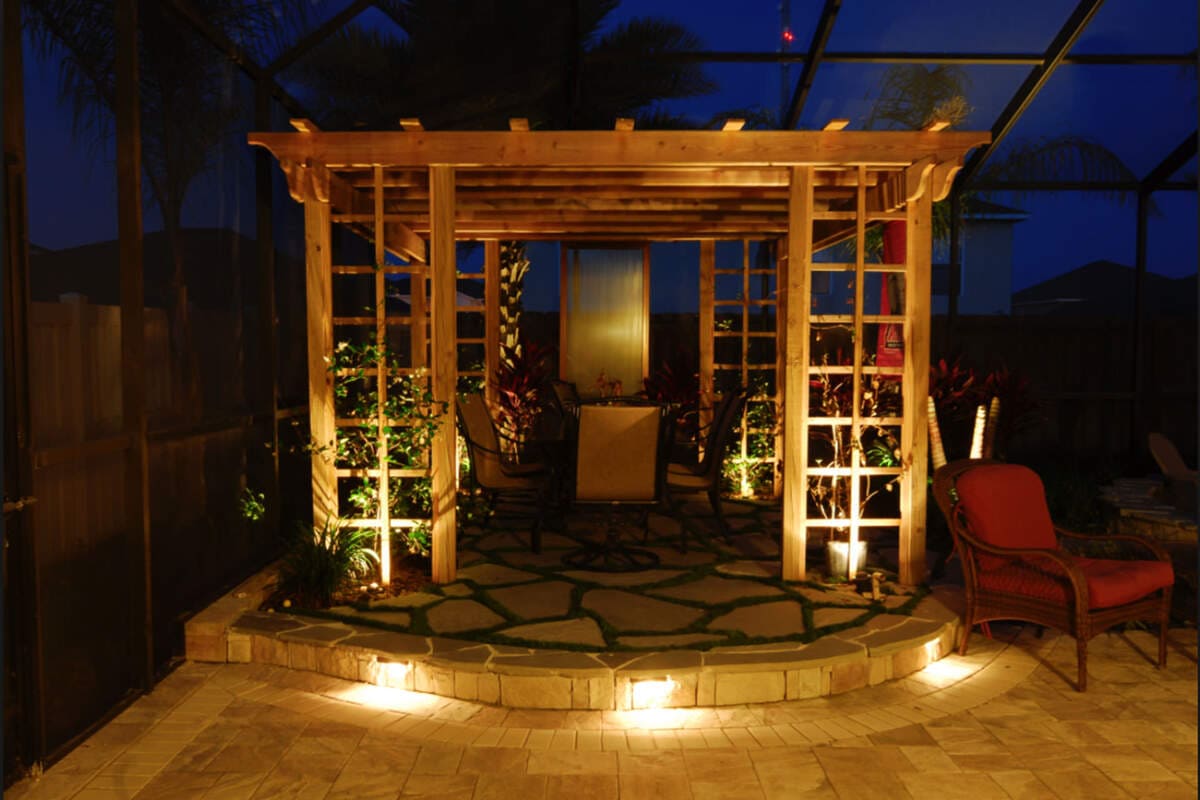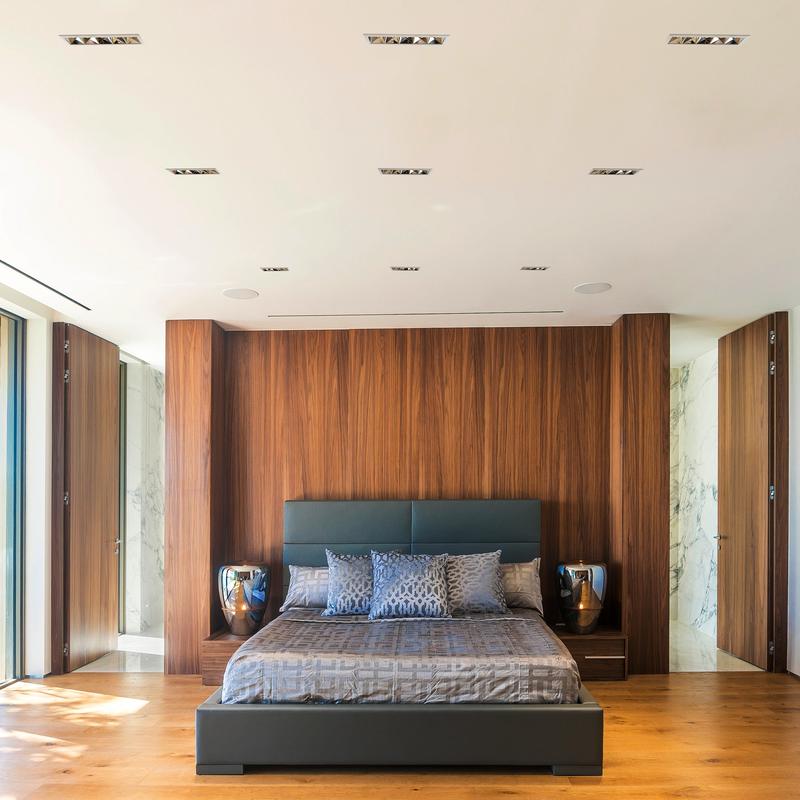تخيل هذا: لقد انخفضت الشمس برشاقة تحت الأفق، لترسم السماء بألوان من اللون الأرجواني الداكن والعنبر. حفيف سعف النخيل اللطيف يرفرف بإيقاع مع نسيم المحيط الناعم، ويمتلئ الهواء بنوع من الهدوء الذي يجعلك تتنفس ضغوط اليوم. الآن، تخيل شيئًا يرتقي بهذا المشهد إلى المستوى التالي من السحر - توهج ناعم وساحر ينسج طريقه حول جذوع أشجار النخيل، ويلقي ضوءًا ذهبيًا يحول مساحتك الخارجية إلى مشهد أحلام. إنها ليست مجرد إضاءة؛ إنها دعوة للاستمتاع بجمال الليل.
أضواء شجرة النخيل الدائرية هي الصلصة السرية لهذا التحول. إنها ليست مجرد أضواء - إنها مصورون مصورون لحديقتك، يسلطون الضوء على الجمال الطبيعي لراحة يدك ويحولون مساحتك إلى ملاذ استوائي يستحق النشر على إنستغرام. سواء كنت تحتسي الكوكتيلات، أو تستضيف تجمعًا حميميًا، أو تستمتع بهدوء المساء، فهذه الأضواء تمهد الطريق.
ولكن دعونا لا ننجرف في الرومانسية دون الاعتراف بالتطبيق العملي وراء هذه الجمالات المتوهجة. لا تقتصر الأضواء الحلقية لشجرة النخيل على جعل الفناء الخلفي الخاص بك يبدو وكأنه قسم لكبار الشخصيات في نادي الشاطئ فحسب، بل إنها عملية أيضًا. في حين أنها تخلق واحة من البهجة الجمالية، فإنها تقدم أيضًا دفعة غير خفية للمتطفلين للحفاظ على مسافة بينهم.
تقوم هذه الأضواء بمهمة مزدوجة، حيث تعمل بمثابة ترقية جمالية وحارس أمان شخصي لك. عند وضعها بشكل استراتيجي، فإنها تحافظ على إضاءة الممرات، وتثبط الأنواع الأقل ودية من التسلل، وتضمن عدم تعثرك فوق قزم الحديقة المارقة. في الأساس، تعتبر الأضواء الحلقية لشجرة النخيل هي المهام المتعددة الأنيقة في عالم الإضاءة الخارجية.
هذا الدليل هنا ليأخذك من مبتدئ الإضاءة إلى العبقري المضيء. سواء كنت تبحث عن التوازن المثالي بين الجمال والأداء الوظيفي أو ترغب فقط في الحفاظ على سطوع أشجار النخيل أكثر من الفناء الخلفي لجيرانك، فأنت في المكان الصحيح. سنرشدك خلال كل ما تحتاج إلى معرفته، بدءًا من اختيار التركيبات المناسبة وحتى اتخاذ قرار بشأن وحدات اللومن (نعم، ستتحدث عن علم الضوء في وقت قصير)، وكيفية التأكد من أن إضاءة شجرة النخيل تعمل بشكل سحري في أي طقس. لذا اربط حزام الأمان، فأنت على وشك تحويل مساحتك الخارجية إلى تحفة فنية متوهجة، ونعم، سنجعل الأمر ممتعًا.
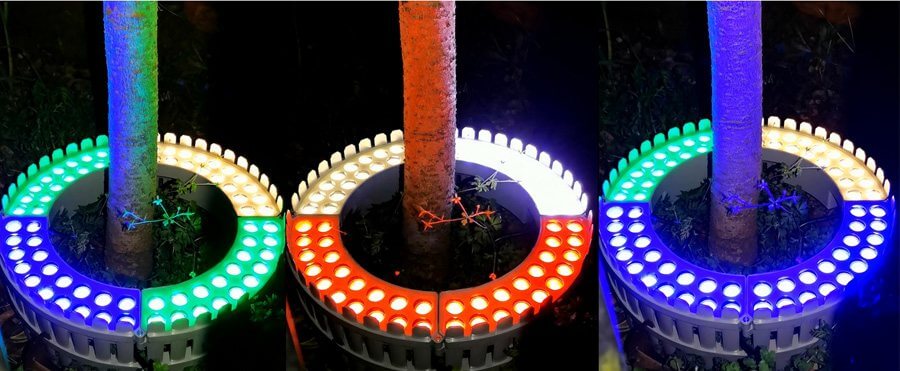
حدد أهداف الإضاءة الخاصة بك: الجمال أم الحارس؟
أ. التحسين الجمالي
الأضواء الحلقية لشجرة النخيل ليست مجرد إضاءة فحسب، بل إنها تخلق الحالة المزاجية. تخيل تحويل حديقتك إلى مشهد من أحلام اليقظة الاستوائية، مع نوع من التوهج السحري الناعم الذي يطلب منك تناول مشروب بارد والاسترخاء. تلتف هذه الأضواء حول راحة يدك مثل عناق دافئ، وتلقي ما يكفي من الضوء لجعل كل شيء يلمع، ولكن ليس بالقدر الذي يجعلك تشعر وكأنك تستضيف استجوابًا. الضوء لطيف، والظلال طويلة، ويتحول الفناء الخلفي لمنزلك فجأة إلى جنة تستحق النشر على إنستغرام. لا حاجة إلى مرشح.
الأمر لا يتعلق فقط بالإضاءة؛ إنها فنية. تأخذ هذه الأضواء حديقتك من عادية إلى غير عادية، من مكان تنمو فيه النباتات ببساطة إلى بيئة تؤدي فيها عمليًا. إنها تسلط الضوء على الأناقة الطبيعية لأشجار النخيل، مما يخلق العمق والملمس. وعندما يضرب هذا الضوء الذهبي الخفيف منحنيات السعف تمامًا، ستشعر وكأن أشجار النخيل قد سرقت الأضواء في معرض راقي.
ب. الاعتبارات الأمنية
الآن، لا تدع المشاعر الغريبة تخدعك، فهذه الجمالات المتوهجة هي أيضًا خط دفاعك الأول. أضواء شجرة النخيل الدائرية لا تجعل حديقتك تبدو جميلة فحسب؛ كما أنهم يعملون بجد للحفاظ على أمانها. فكر فيهم باعتبارهم جيمس بوند للإضاءة، أنيقين، ولطيفين، ولكنهم على استعداد للتصرف إذا لزم الأمر.
من خلال إضاءة الزوايا المظلمة، فإنها تبعث برسالة واضحة إلى أي متطفل محتمل: "تقدم للأمام يا صديقي، لا يوجد شيء تراه هنا!" لا تترك الساحة المضاءة جيدًا مجالًا كبيرًا للأعمال الخادعة، وتقف راحة اليد المتوهجة مثل الحراس، مما يضمن أن الظلال لا تمنح أي شخص مكانًا للاختباء. إنه المزيج النهائي بين الأسلوب والجوهر - الأمان دون الحاجة إلى جدار حصن أو خندق (على الرغم من أن الخندق سيكون رائعًا نوعًا ما).
ج. النهج المتوازن
لماذا تختار بين الجمال والعقل عندما يمكنك الحصول على كليهما؟ مع الأضواء الدائرية المناسبة لشجرة النخيل، لن تضطر إلى التضحية بأحدها من أجل الآخر. يمكنك الاستمتاع بالتوهج الرومانسي الناعم لراحة يدك المضاءة جيدًا مع العلم أن نفس الإضاءة تحافظ أيضًا على المساحة الخاصة بك آمنة. يتعلق الأمر بإيجاد المكان المثالي - التوازن المثالي بين السحر الجمالي والسلامة العملية.
ستحصل على أفضل ما في كلا العالمين: حديقة تبدو وكأنها ملاذ هادئ ولكنها تعمل مثل Fort Knox. تصبح نخيلك تحفة فنية في النهار وحراسة يقظين في الليل. وحقاً، أليس هذا هو الحلم؟ أن يكون لديك ساحة ليست رائعة فحسب، بل أيضًا ذكية بما يكفي لتعتني بها؟
تقييم حجم شجرة النخيل وموضعها: أضيئها بشكل صحيح، فرحة النخيل
أ. ضع في اعتبارك حجم الشجرة
دعونا نوضح شيئًا واحدًا: ليست كل أشجار النخيل متساوية. بعضها عبارة عن عمالقة شاهقة في عالم النباتات، وتتطلب الاهتمام مثل المشاهير الذين يتبخترون على السجادة الحمراء. آحرون؟ إنهم من الأنواع البسيطة والأنيقة، فهم قصيرون ولطيفون ويسعدهم السماح لأبناء عمومتهم الأكبر حجمًا بسرقة العرض. وظيفتك؟ تأكد من أن الإضاءة تناسب شخصيتهم.
إذا كان لديك كف يد يصل إلى النجوم، فسوف يحتاج إلى حل إضاءة يتمتع بجاذبية كافية لتتناسب مع طموحه. فكر بشكل كبير وجريء ومشرق. تريد هذا النوع من الأضواء التي تصرخ، "انظر إلي!" ولكن بطريقة راقية وغير متهورة. تتطلب الأشجار الأكبر حجمًا إنتاجًا أعلى للتجويف، وإضاءة تغمر كل سعفة بتوهج مشع، مما يضمن عدم ترك ورقة نخيل واحدة في الظلام. ولكن إذا كانت شجرتك من النوع المتواضع بحجم الجيب، فافعل ذلك بسهولة. أنت لا تريد التغلب عليها. الدقة هي المفتاح هنا - فكر في الإضاءة الناعمة والحساسة التي تعزز سحرها الطبيعي بدلاً من إغراقها.
ب. مسائل الموقع
المكان الذي تزرع فيه راحة يدك لا يقل أهمية عن كيفية إضاءتها. تصور هذا: شجرة النخيل الرائعة الخاصة بك مضاءة مثل المغنية، ولكن ... إنها عالقة في الزاوية، وغير مرئية عمليًا من الفناء الرئيسي الخاص بك. هذا يشبه استئجار بيونسيه لقضاء ليلة كاريوكي ونسيان تشغيل الميكروفون الخاص بها. مأساوي.
تدور إضاءة شجرة النخيل حول الزوايا والقرب. ضع في اعتبارك مكان تواجد راحة يدك - سواء كانت في وسط حديقتك، أو مخفية مثل شخص انطوائي خجول - وكيف ستضيء أضواءك المناطق المحيطة بها. إن إضاءة شجرتك من الزاوية الخاطئة يمكن أن تلقي بظلال غريبة وغير جذابة (النوع الذي يجعلها تبدو وكأنها تجربة أداء لفيلم رعب). سيسلط الموضع المناسب الضوء على الجمال الطبيعي للشجرة، مما يمنحها العمق والبعد والشعور بالانتماء إلى جنتك الخارجية.
ج. تحقيق التوازن
التماثل. إنه البطل المجهول للتصميم الجيد. عندما يكون لديك العديد من أشجار النخيل في حديقتك، فإن الإضاءة تهدف إلى خلق الانسجام، وليس الفوضى. أنت لا تريد أن تتوهج شجرة واحدة مثل المنارة بينما يجلس جيرانها في الظلام مثل مجموعة من زهور المنجد.
قم بموازنة الإضاءة الخاصة بك لمنح كل شجرة وقتها للتألق - حرفيًا. سواء كنت تصطف صفًا من حراس النخيل أو ترتبهم بنمط أكثر عشوائية، تأكد من توزيع الأضواء بالتساوي. الأمر كله يتعلق بإنشاء تدفق بصري يجعل مساحتك الخارجية تبدو مقصودة، وليس مثل مهرجان الأضواء العشوائية.
د. الإضاءة القوية مقابل الإضاءة الدقيقة
شدة الإضاءة تشبه الملح في الوصفة، إذا زادت عن حده، ستحدث كارثة؛ قليل جدًا، وهو لطيف. بالنسبة لأشجار النخيل الكبيرة والجريئة، اختر إضاءة أكثر قوة لتتناسب مع عظمتها. هذه هي الأشجار التي ترغب في رؤيتها من جميع أنحاء الفناء، وتجذب الانتباه بكل حركة من سعفها المهيبة. فكر في الأضواء الكاشفة، ولكنها أنيقة.
بالنسبة للأشجار الصغيرة، لا تبالغ في ذلك. لا أحد يحب الأضواء عندما لا يكون مستعدًا لالتقاط صور مقربة له. اختر أسلوبًا أكثر دقة - الإضاءة التي تهمس بدلاً من الصراخ. الهدف هو تكملة حجمهم، وليس جعلهم يبدون وكأنهم يلعبون لعبة تلبيس ملابس إخوتهم الأكبر.
اختيار نوع التركيب المناسب: فلنشعل الإضاءة بالطريقة الصحيحة
أ. أضواء حلقة شجرة النخيل المثبتة على الأرض
تشبه الأضواء الحلقية لشجرة النخيل المثبتة على الأرض أساس الزي القاتل - فهي صلبة وموثوقة ومضمونة لجعل كل شيء آخر يبدو رائعًا. تقع هذه الأضواء عند قاعدة أشجار النخيل، وتلقي هالة أنيقة تلتف حول الجذع مثل عناق مسلط الضوء. تخيل أن شجرة النخيل الخاصة بك مغمورة بتوهج أثيري ناعم يسلط الضوء على جمالها الفخم. إنه نوع الإضاءة الذي يقول: "انظر إلي، أنا ملك هذه الساحة!" دون أن تكون متفاخرًا جدًا.
مثالية لأشجار النخيل الطويلة، تعمل الأضواء المثبتة على الأرض على إبراز ارتفاع الشجرة، مما يلفت الانتباه إلى الأعلى مع الحفاظ على إضاءة القاعدة جيدًا. فكر في الأمر على أنه لحظة السجادة الحمراء في راحة يدك، فكل شيء بدءًا من الجذور وحتى القمة يكتسب توهجًا يستحقه. والمكافأة؟ إنها تتيح لك القيام بنزهة ليلية سحرية دون التعرض لخطر التعثر في خرطوم حديقة خاطئ.
ب. أضواء حلقة شجرة النخيل المثبتة على الشجرة
الآن، إذا كنت تريد شيئًا أكثر تكاملاً، فإن المصابيح المثبتة على الشجرة هي خيارك الأمثل. يلتف هؤلاء الصغار حول الجذع، كما لو أن الشجرة نفسها تتوهج من الداخل. لا توجد معدات ضخمة في القاعدة، ولا توجد مخاطر للتعثر - مجرد مظهر طبيعي سلس يجعل الأمر يبدو وكأن شجرة النخيل قد أتقنت فن الإضاءة الحيوية.
تعتبر الأضواء المثبتة على الأشجار مثالية إذا كنت تبحث عن أجواء أنيقة وبسيطة. إنهم لا يسرقون العرض، بل يصبحون جزءًا منه، مما يمنح راحة يدك توهجًا أنيقًا وبسيطًا. يبدو الأمر كما لو أن شجرة النخيل قد قامت للتو بوضع مكياجها بشكل احترافي: رقيق ولكنه ملفت للنظر. والجزء الأفضل؟ يمكنك لف هذه الأضواء أعلى الجذع، مما يعني أنه حتى سعف الشجرة النبيلة يمكن أن تنعم بمجدها المضيء.
ج. أضواء حلقة شجرة النخيل المعلقة
بالنسبة لأولئك الذين يفضلون القليل من النزوة في لعبة الإضاءة الخاصة بهم، فإن الأضواء الدائرية المعلقة لشجرة النخيل هي المكان المناسب لهم. لا تلتصق هذه الأضواء بجذع الشجرة، بل تطفو فوقها، مثل الأجرام السماوية السحرية الصغيرة المعلقة من السماء. مثالية لأشجار النخيل الصغيرة، توفر هذه الأضواء توهجًا لطيفًا ومرحًا يبدو وكأنه قصة خيالية أكثر من إعداد الإضاءة التقليدية. تصور أضواء ناعمة تتراقص فوق شجرة النخيل، وتلقي ظلالاً معقدة وتحول حديقتك إلى شيء مباشرة من تسلسل الأحلام.
يعد هذا الإعداد رائعًا بشكل خاص إذا كنت ترغب في خلق جو ساحر لتناول العشاء أو الحدث في الهواء الطلق. تتمايل الأضواء المعلقة قليلاً مع النسيم، وتحول أشجار النخيل إلى نقاط محورية ساحرة تأسر الضيوف وتضفي لمسة خيالية. دعونا نواجه الأمر - من منا لا يريد تناول العشاء تحت الأشجار المتلألئة بلمسة من السحر؟
د. تخصيص الإضاءة
لماذا تكتفي بنوع واحد فقط بينما يمكنك المزج والتوافق مثل مايسترو الإضاءة؟ الجمع بين الأضواء المثبتة على الأرض والمثبتة على الأشجار والمعلقة يمنح مساحتك الخارجية تأثيرًا ديناميكيًا متعدد الطبقات. إنها مثل سيمفونية من الضوء، حيث تلعب كل وحدة تركيب دورها لإنشاء تركيبة شاملة ساحرة وعملية في نفس الوقت.
يمكنك وضع أضواء مثبتة على الأرض لتسليط الضوء على ارتفاع أطول أشجارك، بينما تؤكد الأضواء المثبتة على الأشجار على الملمس الطبيعي للجذوع. أضف بعض الأضواء المعلقة للحصول على مزيد من السحر، وها أنت قد أنشأت مساحة خارجية مذهلة بصريًا وعملية بقدر ما هي رائعة. الأمر كله يتعلق بخلق تجربة متعددة الأبعاد، حيث يتفاعل الضوء مع الطبيعة ليحول الفناء الخلفي لمنزلك إلى واحة من العجائب المضيئة.
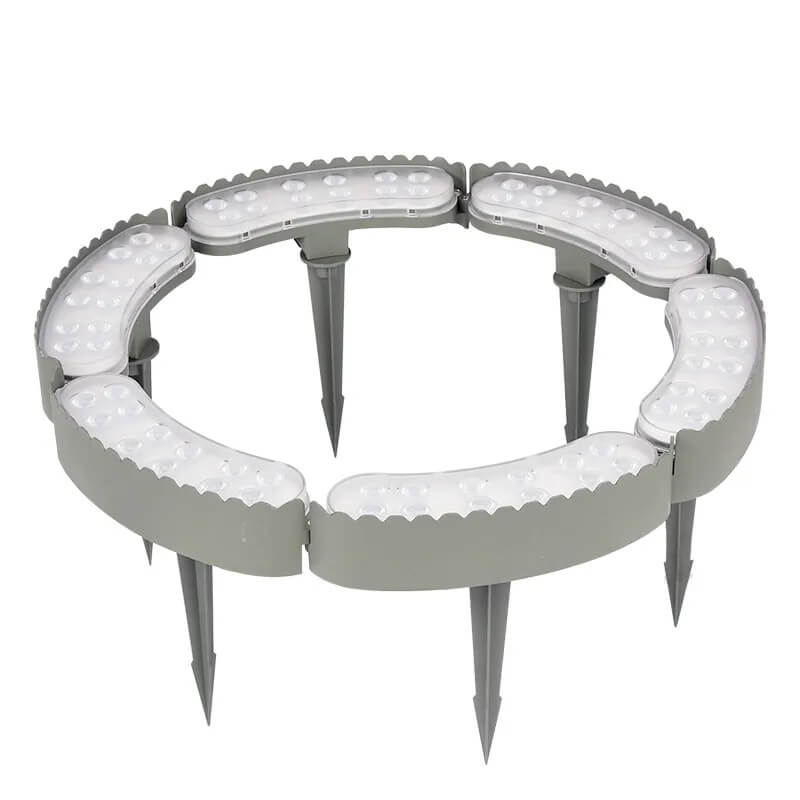
تحديد السطوع المطلوب (لومن): يجب أن يكون هناك (الكمية المناسبة من) الضوء
أ. قم بمطابقة اللومن مع حجم الشجرة
عندما يتعلق الأمر بإضاءة راحة يدك الرائعة، فإن وحدات اللومن هي الأبطال المجهولون. إنهم يهمسون بالقوة الكهربائية، ويتأكدون من أنك لا تضيء الفناء الخلفي لمنزلك مثل شريط فيغاس عندما يكون كل ما تريده هو توهج ناعم ورومانسي. لكن الأشجار الأكبر حجمًا تتطلب المزيد قليلًا. فكر في معدلات اللومن العالية باعتبارها تسليط الضوء على أحد نجوم برودواي: تحتاج راحة اليد الكبيرة إلى قوة إضافية لتبرز وتظهر بكل مجدها المورق.
إذا كانت شجرة النخيل الخاصة بك هي بيونسيه في الفناء الخلفي - طويلة، وبراقة، ومن المستحيل تجاهلها - فسوف تحتاج إلى بعض اللمعان الجدي لمواكبة مكانتها كنجمة. نحن نتحدث عن إضاءة جريئة ومشرقة يمكنها إلقاء الظل (حرفيًا) بأفضل طريقة ممكنة. وفي الوقت نفسه، إذا كانت راحة يدك ذات أداء خفي وخلفية - أقصر، ولكنها جميلة بنفس القدر - فابقها باردة. اللومن المنخفض هو صديقك، فهو يخلق أجواء أكثر حميمية وحساسة. لا حاجة للمبالغة في ذلك.
ب. الموازنة بين الجماليات والوظائف
الآن، قد تعتقد أنه كلما كان أكثر سطوعًا كلما كان ذلك أفضل، أليس كذلك؟ خطأ. أنت لا تضيء ملعبًا هنا، إلا إذا كانت هذه هي الأجواء التي تسعى إليها، والتي لا داعي للحكم عليها. لكن بالنسبة لمعظمنا، يتعلق الأمر بتحقيق التوازن المثالي بين الإضاءة الوظيفية والشيء المريح للعين.
من المؤكد أنك تريد أن تتألق أشجار النخيل، لكنك لا تريد أن تعمي ضيوفك. الهدف هو استكمال مساحتك الخارجية بتوهج يعزز الجمال الطبيعي للأشجار والمناطق المحيطة بها. الكثير من الضوء، وفجأة يبدو الفناء الخلفي الخاص بك وكأنه غرفة استجواب. قليل جدًا، وسيكون لديك أشخاص يتعثرون في أواني الزهور في الظلام. التوازن، عزيزي القارئ، التوازن. اهدف إلى الحصول على السطوع المناسب تمامًا، حيث يلتقي الجمال والوظيفة ويتصافحان مثل الأصدقاء القدامى.
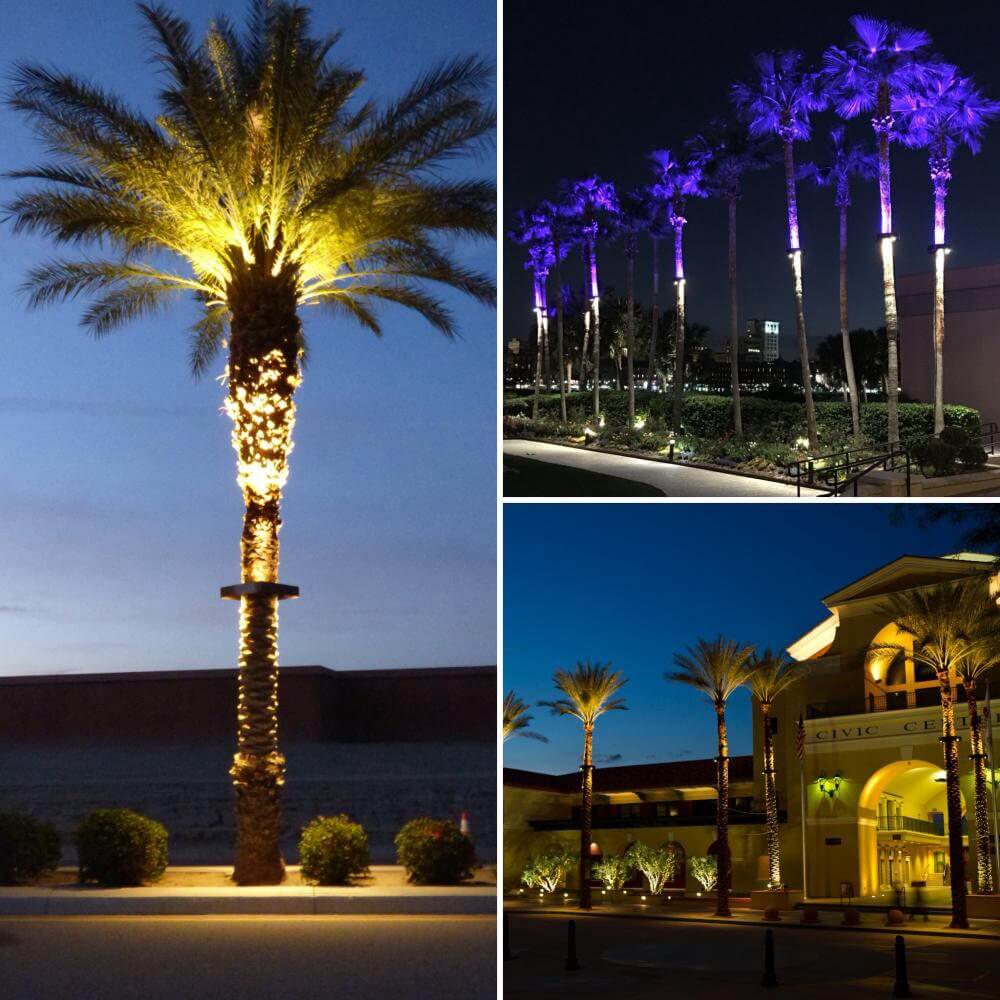
ج. أنظمة الخافتة والتحكم
وهنا يمكنك التحكم حقًا. كما ترى، المزاج هو كل شيء. في دقيقة واحدة قد ترغب في أن تتوهج راحة يدك بهدوء في خلفية عشاء رومانسي. وفي اليوم التالي، ستستضيف حفلًا شاملاً يتطلب إضاءة أكثر سطوعًا وحيوية. أدخل: مفاتيح باهتة وأنظمة التحكم.
المصابيح القابلة لخفت الضوء هي أفضل صديق للإضاءة لديك، حيث تمنحك القدرة على زيادة سطوعها أو خفضها حسب المناسبة. تريد إقناع تاريخك؟ خافتة منخفضة. استضافة حفل الشواء الحي؟ كرنك حتى درجة. تتيح لك أنظمة التحكم أيضًا تشغيل الإضاءة تلقائيًا، حتى تتمكن من ضبط الحالة المزاجية دون رفع إصبعك - لأنه من لديه الوقت للنهوض عندما يكون لديك شريحة لحم مشوية بشكل مثالي على طبقك؟
اختيار درجة حرارة اللون المناسبة: البارد والمريح والملون
أ. الإضاءة الدافئة (2700K-3000K)
الإضاءة الدافئة تشبه العناق الكبير المتوهج لمساحتك الخارجية. هذه الألوان الذهبية الناعمة تغلف أشجار النخيل في توهج رومانسي يهمس، "تعال، اجلس، وابق لبعض الوقت." إنها الإضاءة المكافئة للكشمير - فهي فاخرة وجذابة ومثالية لتلك الأمسيات الحميمة حيث تريد أن يشعر الفناء الخلفي الخاص بك وكأنه ملاذ استوائي مريح. تعتبر درجة حرارة الإضاءة هذه مثالية لتناول العشاء تحت النجوم، حيث يبدو كل شيء أكثر نعومة وحالمًا وأكثر سحرًا قليلاً.
تعتبر النغمات الدافئة (2700K-3000K) مثالية لخلق جو يقول، "استرخِ، استرخِ، وربما تناول كأسًا ثانيًا من النبيذ." إنها بطانية مريحة من الضوء تحول راحة يدك إلى حراس ذهبيين من الهدوء، مما يجعل الجميع يشعرون وكأنهم في منتجع شاطئي خاص - بدون الرمال الموجودة في أحذيتهم.
ب. الإضاءة البيضاء الطبيعية (4000K-5000K)
الآن، إذا كانت الإضاءة الدافئة عبارة عن همس ناعم، فإن الإضاءة البيضاء الطبيعية تعد إعلانًا واثقًا. إنه الضوء الواضح والنظيف الذي يقول: "أنا هنا لإنجاز الأمور". في نطاق 4000K-5000K، تحقق الإضاءة البيضاء الطبيعية التوازن المثالي بين الدفء والبرودة، مما يوفر الوضوح دون القسوة. هذه هي الإضاءة التي تريدها إذا كنت تعرض التفاصيل الدقيقة لمساحتك الخارجية - تلك السعف المرتبة ببراعة، والخطوط النظيفة لتخطيط حديقتك، والعشب الذي تمت صيانته بدقة ولم تستعين بمصادر خارجية على الإطلاق لمحترفين.
إنها الإضاءة للتنوع. سواء كنت تستضيف عشاءً أنيقًا أو حفلة مريحة في الحديقة، فإن الضوء الأبيض الطبيعي يضفي على مساحتك طابعًا راقيًا وسهل الوصول إليه. إنه حديث، وأنيق، ومتعدد الاستخدامات بما يكفي للتعامل مع أي حدث تقام فيه - بدءًا من نوادي الكتب الهادئة وحتى الحفلات الصاخبة في الفناء الخلفي.

ج. الإضاءة البيضاء الباردة (6000K-6500K)
إذا كنت بحاجة إلى الرؤية، فالإضاءة البيضاء الباردة هي خيارك الأمثل. إنه المصباح الأمامي لعالم الإضاءة - مشرق وقوي ومن المستحيل تجاهله. في نطاق 6000K-6500K، توفر الإضاءة البيضاء الباردة تألقًا حادًا وواضحًا مثاليًا للأمان والمساحات التي تريد فيها أقصى قدر من الإضاءة. هذه ليست الإضاءة المناسبة لتلك الأمسيات الرومانسية الهادئة، بل هي الإضاءة المناسبة عندما تحتاج إلى رؤية كل ورقة وكل فرع وكل مخلوق يجرؤ على التجول في حديقتك.
الضوء الأبيض البارد يعني العمل. إنها مثالية لتلك الزوايا المظلمة من الممتلكات الخاصة بك حيث تكمن الظلال، مما يضمن أن أشجار النخيل الخاصة بك لا تبدو جميلة فحسب، بل تتضاعف أيضًا كضمان ضد الضيوف غير المرحب بهم (سواء النوع ذي الأرجل أو الأربعة أرجل). مع الإضاءة البيضاء الباردة، فإنك لا تضيء الليل فحسب، بل تغزوه أيضًا.
د. خيارات RGB وRGBW
هل تشعر بالقليل من الإبداع؟ هل تريد إضافة بعض البيتزا إلى أشجار النخيل الخاصة بك؟ تعد خيارات RGB وRGBW بمثابة الإضاءة المكافئة لرمي هذيان استوائي في الفناء الخلفي لمنزلك. مع القدرة على التبديل بين مجموعة كاملة من الألوان، تتيح لك هذه الأضواء تحويل أشجار النخيل إلى أعمدة متوهجة من المرح. استضافة حفلة؟ اضبطها على اللون الأرجواني النابض بالحياة أو الأحمر الناري. هل تخطط لحدث عطلة؟ قم بتزيينها باللونين الأخضر والأحمر الاحتفالي. شعور وطني؟ الذهاب الأحمر والأبيض والأزرق.
إن إضاءة RGB ليست عملية فقط؛ إنها متعة نقية وغير مغشوشة. يمكنك تخصيص الألوان لتتناسب مع أي موضوع أو مزاج أو حتى ملابسك (لماذا لا؟). وإذا كنت ترغب في الحصول على مظهر خيالي، فإن RGBW تضيف خيار الضوء الأبيض إلى المزيج، مما يمنحك المزيد من المرونة لصياغة الجو المثالي لأي حدث. مع هذه الأضواء، ستكون راحة يدك هي حياة الحفلة، وتسرق الأضواء بألوانها المتغيرة باستمرار، وتجعل الفناء الخلفي لمنزلك أكثر الأماكن التي يتم الحديث عنها في الحي.
خذ بعين الاعتبار تأثيرات الإضاءة: دعونا نضيف بعض الدراما إلى تلك النخيل
أ. التنوير
هل تريد أن تجعل شجرة النخيل الخاصة بك تبدو وكأنها نجم سينمائي درامي تم إلقاء القبض عليه في دائرة الضوء في الوقت المناسب تمامًا؟ Uplighting هو الطريق للذهاب. يأخذ هذا التأثير الضوء من الأرض ويطلقه إلى الأعلى، مع التركيز على السعف والجذع كما لو كانوا ضيوفًا من كبار الشخصيات في حفل حديقة ساحر. تخيل أن الأضواء تلقي ظلالاً طويلة وجريئة تمنح راحة يدك حضورًا مسرحيًا تقريبًا، كما لو كانت على وشك الوقوف على السجادة الحمراء - أو على الأقل تتمايل مع جو من الأهمية.
Uplighting هو كل شيء عن خلق الدراما. إنه يبرز الارتفاع الشاهق لشجرتك، مما يجعل السعف تتطاير في مشهد متوهج بينما يقف الجذع مضاءً بفخر. إنه نوع الإضاءة الذي يقول، "هذه الشجرة؟ إنها مشكلة كبيرة." سواء كنت تهدف إلى الحصول على أناقة خفية أو عرض كامل، فإن الإضاءة لأعلى هي خيارك الأمثل لتحويل كف قديم عادي إلى العنوان الرئيسي للمناظر الطبيعية الخاصة بك.
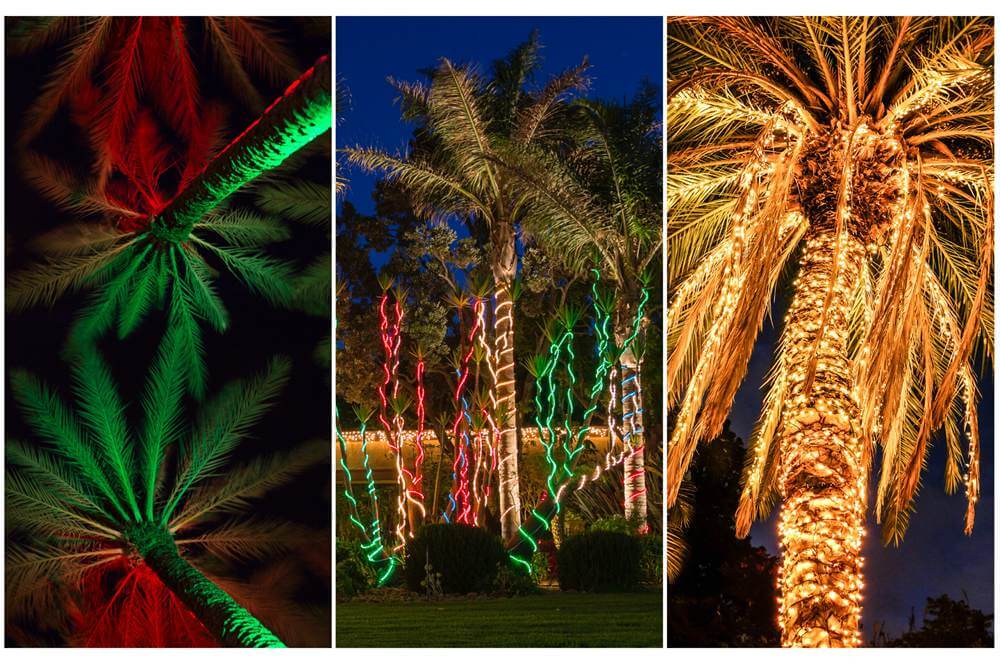
ب. الإضاءة النازلة
إذا كانت الإضاءة العلوية هي أضواء هوليوود، فإن الإضاءة السفلية هي الحضن الدافئ لليلة مقمرة. تتخذ الإضاءة النازلة أسلوبًا أكثر نعومة ودقة، حيث تسلط الضوء نحو الأسفل مثل وابل لطيف من التوهج. تصور هذا: أشجار النخيل تنعم تحت شعاع من الضوء يحاكي وهج القمر المهدئ، مما يجعل كل شيء يبدو أكثر سحرًا. يقبل الضوء الأوراق بلطف ويلقي ظلالاً ناعمة على الأرض، مما يجعله مثاليًا لخلق الأجواء المريحة والهادئة التي كنت تحلم بها.
هذا التأثير لا يصرخ لجذب الانتباه، بل يهمس به بهدوء. الإضاءة السفلية مخصصة لتلك اللحظات التي تريد فيها أن تبدو مساحتك الخارجية وكأنها حديقة سرية، يغمرها الجمال الهادئ. إنه مثالي للباحات أو الممرات أو أي مكان تريد فيه تقليد الأناقة الطبيعية لضوء القمر. بالإضافة إلى ذلك، لا يوجد ذئاب ضارية في الأفق. فقط أشجار النخيل الهادئة والمتوهجة.
ج- ضوء القمر
العمل الإضافي هو أقصى درجات مشاعر الغابة المسحورة. لا، نحن لا نتحدث عن بروس ويليس في الثمانينيات، بل نتحدث عن هذا التأثير الساحر حيث يبدو الضوء وكأنه يتسلل عبر أوراق شجرة النخيل كما لو أن القمر نفسه قرر التسكع في الفناء الخلفي لمنزلك. من خلال وضع الأضواء داخل المظلة، يمكنك إنشاء توهج ناعم ومرقط يومض ويتراقص بينما تتحرك السعف مع النسيم. إنه سحر خالص.
هذا التأثير هو ما يحدث عندما تريد أن تبدو حديقتك وكأنها قصة خيالية. يخترق الضوء المظلة بلطف، ويلقي أنماطًا معقدة على الأرض مثل مشهد الطبيعة. إنه نوع الإضاءة الذي يحول الأمسية العادية إلى شيء من حلم غريب الأطوار. لذا، إذا كنت تبحث عن جو تتوقع فيه أن تبدأ مخلوقات الغابة في الغناء، فإن العمل الإضافي هو إجابتك.
اختيار مصابيح LED الموفرة للطاقة: أفكار مشرقة لتحقيق وفورات رائعة
أ. كفاءة الطاقة
دعونا نتحدث عن أفضل العناصر المتوهجة للإضاءة الخارجية - مصابيح LED. تشبه هذه القوى الصغيرة السيارات الهجينة في عالم الإضاءة: فهي تمنحك كل السطوع دون استهلاك الطاقة مثل المصباح المتوهج من المدرسة القديمة. تستهلك مصابيح LED الكهرباء بدلاً من ضخها، مما يعني انخفاض استهلاك الطاقة وفاتورة أقل بكثير في نهاية الشهر. من منا لا يحب أن يدفع أقل مقابل إضاءة الليل؟
ولا تقلق، فهذه الأضواء لا تقلل من طاقتك لتوفير الطاقة. لا، إنها مشرقة بقدر ما تحتاج إليها، مع الحفاظ على بصمتك الكربونية خفيفة مثل الريشة. لذا، يمكنك الاستمتاع بجنة مضاءة جيدًا دون الشعور وكأنك تسببت بمفردك في أزمة بيئية. فعالة وصديقة للبيئة وواعية بالميزانية؟ إنه فوز مربح للجانبين.
ب. عمر ممتد
هذا هو المكان الذي تتقدم فيه مصابيح LED في السباق - طول العمر. هذه الأضواء هي عدائي الماراثون في عالم الإضاءة. في حين أن المصابيح التقليدية قد تنطفئ في منتصف الحفلة، إلا أن مصابيح LED تظل موجودة على المدى الطويل. نحن نتحدث عن آلاف وآلاف الساعات من الضوء، وبعضها يمكن أن يستمر لمدة تصل إلى 25000 ساعة أو أكثر. هذا يشبه 1000 جلسة مشاهدة على Netflix، أو ما يكفي من الوقت لأشجار النخيل الخاصة بك لتنمو أطول قليلاً بينما لا تزال تنعم بنفس التوهج الثابت.
إن الإرهاق الأقل يعني صيانة أقل، مما يعني سلالم أقل، ومصابيح أقل، والمزيد من الوقت للاسترخاء والاستمتاع بساحتك المضاءة بشكل مثالي. لذلك، إذا لم يكن تغيير المصابيح فكرتك لقضاء وقت ممتع (ولنكن صادقين، من هي هذه الفكرة؟)، فإن مصابيح LED هي رفيقة الإضاءة المخلصة التي لا تحتاج إلى صيانة والتي كنت تحلم بها.
ج. المتانة
Let’s face it—outdoor lighting isn’t for the faint of heart. Between the rain, wind, dust, and the occasional squirrel party in your trees, your lights have to be tough. Luckily, LEDs are built to handle all the elements Mother Nature throws their way. They’re shock-resistant, vibration-proof, and capable of withstanding even the harshest weather conditions without flickering out or calling it quits.
مصابيح LED هي مركبات الإضاءة الوعرة لجميع التضاريس. إنها تزدهر في البيئات الخارجية حيث قد تنهار المصابيح الأخرى أو تتشقق أو تفشل بشكل بائس. سواء كنت تعيش في مناخ عاصف، أو صحراء متربة، أو لديك أطفال يتعاملون مع الفناء كملعب رياضي، فإن هذه الأضواء ستستمر في السطوع. لذا تفضل، دع المطر ينهمر والرياح تعوي. مصابيح LED الخاصة بك لن تذهب إلى أي مكان.
مراجعة مقاومة الطقس: حافظ على إضاءة مصابيحك، سواء كانت ممطرة أو مشمسة
أ. أهمية تقييمات الملكية الفكرية
When it comes to outdoor lighting, IP ratings are the unsung heroes, quietly protecting your precious fixtures from the elements. Think of them like the bodyguards for your palm tree lights—keeping the dust, dirt, and raindrops far away from the delicate inner workings. And here’s the kicker: the higher the IP rating, the tougher the protection.
إذن ما هو الرقم السحري؟ ابحث عن تصنيف IP لا يقل عن 65. وأي شيء أقل من ذلك، فأنت تثير المتاعب. IP65 يعني أن المصابيح الخاصة بك يمكنها تحمل الغبار والرطوبة وجميع الجزيئات الخادعة التي ترغب في إحداث الفوضى في إعدادك. إنه مثل وضع أضواءك في بدلة مدرعة وإرسالها إلى براري الفناء الخلفي لمنزلك، في مأمن من العواصف الترابية والأمطار الاستوائية على حد سواء.
ب. مناسبة للاستخدام في الهواء الطلق
دعونا نوضح شيئًا واحدًا، الإضاءة الخارجية يجب أن تكون قوية. ليس "أستطيع رفع بعض الدمبل" صعبًا، ولكن "أستطيع النجاة من الإعصار وما زلت أبدو رائعًا". ستواجه أضواء شجرة النخيل الخاصة بك جميع أنواع الطقس - الحرارة الشديدة، والأمطار الموسمية، والبرد القارس، ولحظة "الطقس رطب للغاية وتتطاير نظارتي".
عندما تختار الإضاءة، يجب أن تضحك في مواجهة سوء الأحوال الجوية. نحن نتحدث عن التركيبات التي لن تستسلم عندما تنفتح السماء أو عندما تصل أول ليلة شتوية فاترة. لذا، سواء كنت تخبز تحت شمس الصيف أو تواجه عاصفة رعدية مفاجئة، فأنت بحاجة إلى مصابيح لا تومض أو تتلاشى أو تتلاشى. المواد القوية، والختم المناسب، والمتانة في جميع الأحوال الجوية هي أمور غير قابلة للتفاوض. لأنه، بصراحة، إذا كانت أشجار النخيل الخاصة بك يمكنها أن تزدهر في الهواء الطلق، فيجب أن تزدهر أضواءك أيضًا!
تقييم التثبيت والأسلاك: دعونا نضيء الأمر بدون الدراما
أ. بساطة التثبيت
إذا سبق لك أن حاولت تجميع قطعة من الأثاث المسطح وانتهى بك الأمر بمجموعة من البراغي وشعور غامر بأنك فاتك شيء ما، فأنت تعرف لماذا يعد التثبيت البسيط أمرًا كبيرًا. عندما يتعلق الأمر بالإضاءة، اختر التركيبات التي لن تجعلك تشعر وكأنك تحاول حل مكعب روبيك في الظلام. ابحث عن تلك التي تصرخ عمليًا "منسم سهل" فور إخراجها من الصندوق.
هذه هي الأضواء التي تأتي مع تعليمات واضحة، ونقاط تثبيت محددة مسبقًا، وربما حتى فيديو تعليمي (لأن من يقرأ الأدلة هذه الأيام؟). نقاط إضافية إذا كانت التركيبات مصممة ليتم تثبيتها باستخدام مفك براغي فقط وتحديد شخص لا يتصل بالمحترف. أنت تريد إضاءة ترتفع بسهولة مثل تعليق إطار الصورة، وليس شيئًا يجعلك تفكر في تغيير مهنتك إلى الهندسة الكهربائية.
ب. المساعدة المهنية
ولكن، وهذا أمر كبير، ولكن في بعض الأحيان يستحق الأمر الاتصال بالمحترفين. إذا بدأ إعداد الإضاءة لديك يشبه مشهدًا من فيلم "Mission Impossible" حيث تمتد الأسلاك في كل اتجاه، وبدأت تتعرق كثيرًا لمشروع DIY يوم السبت، فقد حان الوقت للتوقف مؤقتًا. قد تحتاج الإعدادات المعقدة، خاصة تلك التي تتضمن الأسلاك الصلبة أو التعامل مع مصادر طاقة متعددة، إلى شخص لديه تدريب فعلي.
يمكن للكهربائي المحترف أن ينقض عليك مثل بطل الإضاءة الخاص بك، مما يضمن أن كل شيء آمن وفعال، والأهم من ذلك أنه لن يتركك مع انقطاع التيار الكهربائي أو الصمامات المنفجرة. بالإضافة إلى ذلك، من المحتمل أن يقوموا بذلك بشكل أسرع مما يمكنك البحث عنه في جوجل "كيفية توصيل مصابيح خارجية دون أن تصعق نفسك بالكهرباء".
ج. اعتبارات الأسلاك
عندما يتعلق الأمر بتوصيل أضواء شجرة النخيل الخاصة بك، فلن يفي أي سلك تمديد آخر بالغرض. أنت بحاجة إلى أسلاك بارعة في التعامل مع الأماكن الخارجية مثل أشجار النخيل. يمكن أن يكون الهواء الطلق مكانًا صعبًا للأسلاك، فالمطر والرياح والمخلوقات الصغيرة التي لديها ميل لمضغ الأشياء كلها مخاطر محتملة. لذلك، تحتاج إلى التأكد من أن نظام الأسلاك الذي تختاره متين بما يكفي للتعامل مع كل ذلك، دون الاستسلام في منتصف الطريق.
ابحث عن الأسلاك المقاومة للعوامل الجوية، ويفضل أن تكون مع بعض العزل الجيد، والمصممة للاستخدام الخارجي. وأثناء قيامك بذلك، تأكد من أن إعداد الطاقة على قدم المساواة. يجب أن يكون النظام الكهربائي في منزلك قادرًا على التعامل مع الحمل الإضافي للإضاءة الخارجية لديك دون تعطيل الكسارة في كل مرة تقوم فيها بقلب المفتاح. الأسلاك الصحيحة تعني أن أشجار النخيل الخاصة بك ستظل مضاءة بشكل رائع، بغض النظر عما تلقيه الطبيعة الأم عليها - أو عدد الأجهزة التي تقوم بشحنها في الداخل.
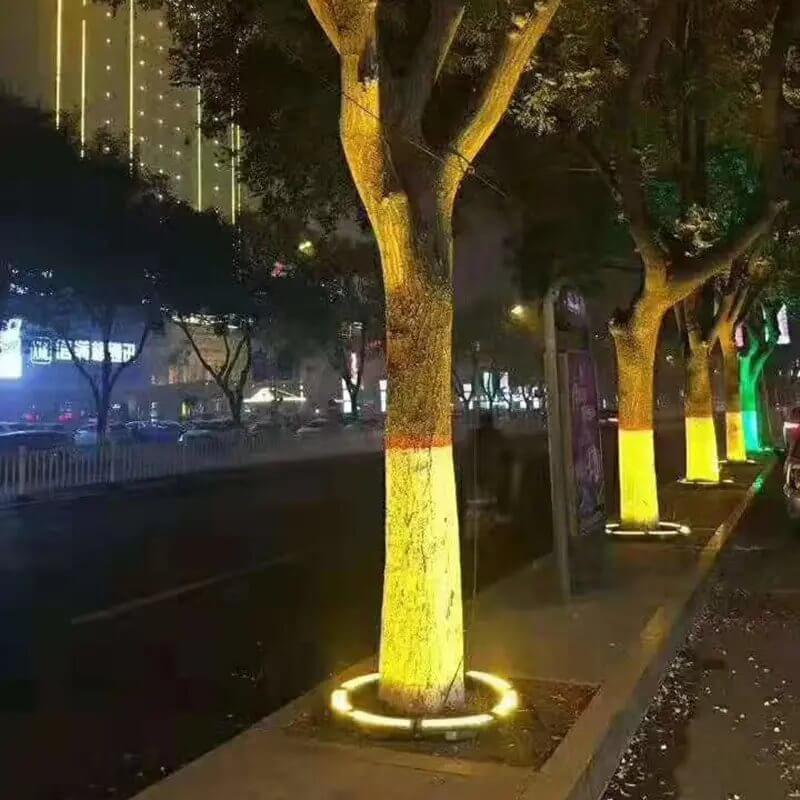
خيارات التحكم في أضواء شجرة النخيل: من منا لا يحب عرض الضوء الجيد؟
أ. ميزات عكس الضوء
لنكن واقعيين، الإضاءة ليست مقاسًا واحدًا يناسب الجميع. في بعض الأحيان تحتاج إلى سطوع كامل "لإضاءة السماء"، وفي أحيان أخرى تحتاج فقط إلى توهج ناعم يقول: "مرحبًا، تعال واسترخي تحت هذه الشجرة". هذا هو المكان الذي تأتي فيه الأضواء الخافتة، وثق بي، إنها تغير قواعد اللعبة. سواء كنت تهيئ الحالة المزاجية لعشاء حميم تحت النجوم أو تستضيف حفلة في الفناء الخلفي تنافس مهرجانًا موسيقيًا، فإن الميزات القابلة للتعتيم تمنحك التحكم الكامل في السطوع.
One minute, your palms are bathing in a soft, romantic glow. The next, they’re radiating like they’re the centerpiece of a Hollywood movie premiere. You get to decide. Dimming your lights is like adjusting the volume on your favorite song—sometimes you need it low and smooth, and other times you want to crank it up and dance.
B. Color Customization
لماذا تلتزم باللون الأبيض القديم البسيط عندما تصبح أضواء شجرة النخيل الخاصة بك هي حياة الحفلة؟ مع تخصيص الألوان، يمكنك تبديل الأشياء في كل مناسبة. هل تريد إقامة حفلة عيد ميلاد تحت عنوان النيون؟ ضرب اللون الوردي الساطع والأزرق الكهربائي. هل تستضيف حفلة شواء صيفية مريحة؟ سيضفي العنبر الدافئ اللطيف الأجواء. هل تخطط لحفلة الهالوين المخيفة؟ نعم، لقد خمنت ذلك - اغسل أشجارك باللون الأرجواني والأخضر الغريب.
إنه مثل أن يكون لديك مصمم الإضاءة الشخصي الخاص بك، ولكن بدون ميزانية هوليود. سواء كنت تحتفل، أو تسترخي، أو تشعر بالروعة، فإن الأضواء المتغيرة الألوان تتيح لأشجار النخيل أن تتناسب مع الحالة المزاجية. تفضل، دلل راحة يدك بخزانة الإضاءة - فهي تستحق ذلك.
ج. التحكم عن بعد والذكية
لماذا تستيقظ عندما يمكنك التحكم في إعداد الإضاءة بالكامل وأنت مستريح على كرسي الصالة الخاص بك؟ أدخل خيارات التحكم عن بعد والتحكم الذكي، لأنه إذا لم تتمكن من ضبط أضواء شجرة النخيل من هاتفك، فهل تعيش في المستقبل؟
باستخدام أجهزة التحكم عن بعد، يمكنك تغيير السطوع أو تبديل الألوان أو حتى إيقاف تشغيل كل شيء بنقرة واحدة فقط. ولكن السحر الحقيقي يحدث مع الضوابط الذكية. تخيل أنك تطلب من أضواء منزلك أن "تخفت" أو "تتحول إلى اللون البرتقالي لغروب الشمس" بمجرد التحدث إلى مساعد منزلك الذكي. هذا صحيح، فالأوامر الصوتية والتطبيقات تحكم العالم الآن، وأشجار النخيل ليست استثناءً.
تتيح لك أنظمة الإضاءة الذكية أتمتة كل شيء بدءًا من غروب الشمس وحتى ضوء النجوم، ومزامنة الأضواء مع الطبيعة أو جدول حفلتك. كل ذلك من هاتفك، أو ربما بمجرد الصراخ، "أليكسا، اجعلها ديسكو!" مثالي لأي شخص يحب التكنولوجيا مع جانب من المرح.
تحكم متقدم باستخدام أنظمة DMX: تحويل أشجار النخيل إلى نجوم عرض ضوئي
أ. ما هو التحكم DMX؟
التحكم DMX يشبه بيونسيه في أنظمة الإضاءة - يمكنه فعل كل شيء ويبدو رائعًا أثناء القيام بذلك. اختصار لـ Digital Multiplex، DMX هو نظام عالي التقنية يسمح لك بتصميم الرقصات الخاصة بك مثل محرك الدمى الرئيسي. نحن نتحدث عن تحويل أشجار النخيل إلى فنانين، حيث يكون كل ضوء ولون وحركة تحت سيطرتك. فكر في الأمر باعتباره التمريرة النهائية خلف الكواليس للتحكم في كل شعاع، وصولاً إلى جزء من الثانية.
With DMX, you’re no longer just flipping switches—you’re orchestrating a light symphony. Want the lights to change color on cue? Check. Need them to pulse along to your favorite playlist? You got it. This system takes your palm tree lighting from “oh, that’s nice” to “whoa, is this a concert?” It’s the difference between a casual backyard gathering and a fully staged production, complete with an encore performance from your glow-in-the-dark fronds.
B. Synchronized Lighting Effects
دعونا نتحدث عن أفضل ما يفعله DMX: تأثيرات الإضاءة المتزامنة. هذه ليست الصفقة المتوسطة التي تقول "دعونا نعمل جميعًا في نفس الوقت". مع DMX، يمكنك برمجة أضواء شجرة النخيل الخاصة بك لترقص معًا في تناغم تام. تخيل موجات من الضوء تموج على أشجارك، أو سلسلة من الألوان تنتقل من كف إلى أخرى مثل سباق تتابع الإضاءة.
You can get as fancy as you want—fade between colors, pulse to the beat of music, or create dynamic lighting sequences that will make your neighbors think they’ve stumbled into an outdoor rave. DMX lets you coordinate every single light, creating patterns and rhythms that transform your yard into a technicolor masterpiece. It’s like giving your palm trees rhythm and stage presence—who knew plants could have that much personality?
C. Ideal for Large or Complex Setups
يأتي التحكم في DMX في حد ذاته حقًا عندما يكون لديك الكثير مما يحدث. إذا كانت طموحاتك في مجال الإضاءة كبيرة مثل العرض المسرحي في فيغاس، فإن DMX هو صديقك المفضل الجديد. لقد تم تصميمه خصيصًا للإعدادات الكبيرة والمعقدة حيث تكون الدقة أمرًا أساسيًا. سواء كنت تضيء صفًا طويلًا من أشجار النخيل، أو تخلق منظرًا طبيعيًا متعدد الطبقات من النباتات المختلفة، أو ترغب فقط في تقديم عرض ضوئي للأعمار، فإن DMX تقدم لك ذلك.
إنها مثالية بشكل خاص للأحداث واسعة النطاق أو المساحات التي تتطلب تحكمًا مطلقًا في كل وميض وفلاش. استضافة حفل زفاف؟ يمكنك تغيير أضواء شجرة النخيل الخاصة بك من اللون الوردي الرومانسي الناعم إلى اللون الأزرق الكهربائي الذي يستحق الرقص مع ارتفاع حرارة الحفلة. رمي حدث الشركات؟ يمكنك تمييز حديقتك بأكملها بألوان الشركة التي تتغير وتلمع طوال الليل. باختصار، DMX ليس مجرد نظام تحكم - إنه بوابتك لتصبح مدير الإضاءة لمنظرك الخارجي المذهل.
اعتبارات الجودة والضمان: لأن أشجار النخيل الخاصة بك تستحق الأفضل
أ. أهمية اختيار الشركات المصنعة ذات السمعة الطيبة
دعونا نواجه الأمر - الإضاءة لا تقتصر فقط على رمي بعض المصابيح على أشجار النخيل وإنهاء الأمر نهائيًا. إذا كنت تريد مصابيح تصمد أمام اختبار الزمن (والطقس)، فعليك اختيار المحترفين. وهذا يعني الابتعاد عن سلة الصفقات واختيار المنتجات عالية الجودة من الشركات المصنعة التي تعرف بالفعل ما تفعله. فكر في الأمر مثل الاختيار بين برجر للوجبات السريعة ووجبة شهية - بالتأكيد، الخيار الرخيص يعمل في حالة حرج، ولكن اختيار الجودة سوف يجعلك راضيًا لفترة أطول.
الشركات المصنعة ذات السمعة الطيبة لا تقوم فقط بجمع الأضواء معًا والأمل في الأفضل. إنهم يستثمرون في البحث والاختبار والابتكار للتأكد من أن منتجاتهم لن تتلاشى بعد ليلة ممطرة. تريد أن تثق في أن إضاءة شجرة النخيل الخاصة بك يمكنها التعامل مع كل شيء بدءًا من هطول الأمطار المفاجئة وحتى حرارة الصيف الحارقة دون أن ترمش - حرفيًا. لذا، استثمر في الجودة. سوف تشكرك أشجارك (وفاتورة الكهرباء الخاصة بك) على ذلك.
ب. الضمان ودعم العملاء
الآن، حتى أفضل الأفضل يمكن أن يكون لديه يوم عطلة. لهذا السبب الضمانات هي سلاحك السري. عندما تقوم بإنفاق المال لشراء أضواء شجرة النخيل، فإنك تريد راحة البال التي تأتي مع ضمان قوي. الضمان القوي يشبه بوليصة التأمين لاستثمارك المتوهج. تقول: "مرحبًا، نحن نقف بجانب أضواءنا، وإذا حدث خطأ ما، فإننا ندعمك."
ابحث عن الضمانات التي لا تغطي الأساسيات فحسب، بل أيضًا أي عوائق غير متوقعة. وأثناء وجودك فيه، تحقق من دعم العملاء. تريد شركة يسهل الوصول إليها، ومفيدة، ولا تضعك في الانتظار لساعات عندما تحتاج إلى المساعدة. لأنه لنكن واقعيين، ليس هناك ما هو أسوأ من وجود أشجار النخيل في الظلام ولا يوجد أحد تلجأ إليه للحصول على إجابات. تعد الضمانات القوية ودعم العملاء الذي يمكن الوصول إليه من السمات المميزة لشركة تهتم بالحفاظ على ساحة منزلك مشرقة مثل توقعاتك.
اعتبارات الميزانية: تألق بشكل مشرق دون كسر البنك
أ. الموازنة بين الجودة والسعر
هذا هو ما يتعلق بإضاءة شجرة النخيل: تحصل على ما تدفع مقابله. من المؤكد أن هذه المصابيح الرخيصة للغاية قد تبدو وكأنها سرقة في البداية، إلى أن تومض بعد بضعة أشهر، تاركة أشجار النخيل في الظلام ومحفظتك تبكي من كل البدائل. قد تأتي الإضاءة عالية الجودة مصحوبة بقليل من الصدمة مقدمًا، ولكن هنا تكمن أهميتها - فهي ستوفر لك المال على المدى الطويل.
لماذا؟ حسنًا، لأن تلك الأضواء المميزة لا تبدو خيالية فحسب. لقد تم تصميمها لتدوم طويلاً. إنها موفرة للطاقة، مما يعني أنها ستمنع فاتورة الكهرباء من الارتفاع بشكل كبير. بالإضافة إلى ذلك، لن تكون هناك حاجة إلى استبدالها في كل مرة يقرر فيها الطقس حدوث نوبة غضب. لذلك، على الرغم من أنك قد تشعر بالوخز في البداية، إلا أنك ستشعر بالتربيت على ظهرك لاحقًا عندما لا تزال الأضواء متوهجة بقوة ويكون جارك عالقًا في التحسس بمجموعته الخامسة من المصابيح الرخيصة.
ب. القيمة طويلة المدى
Investing in quality lighting isn’t just about avoiding the hassle of constant replacements—it’s about the peace of mind that comes with knowing your palm trees are lit up in style for years to come. Think of it as putting your money into a long-term relationship instead of a summer fling. You don’t want lights that burn bright and then ghost you after a season. You want fixtures that are reliable, resilient, and there for the long haul.
تم تصميم التركيبات عالية الجودة للتعامل مع العناصر - سواء كانت الحرارة أو المطر أو الطيور العرضية التي تقرر أن راحة يدك هي المكان المثالي. ولأنها تدوم لفترة أطول، فلن تضطر إلى استبدالها كل عام، مما يوفر لك الوقت والمال. لذلك، عندما يتعلق الأمر بميزانية إضاءة شجرة النخيل، فكر في الأمر على أنه أقل من النفقات وأكثر من ذلك كاستثمار في الأجواء الخارجية التي ستستمر في تحقيق النتائج - عامًا بعد عام، وموسمًا بعد موسم.
الإضاءة العلوية وتقنيات إضاءة شجرة النخيل الخاصة: دعونا نجعل أشجار النخيل هذه بارزة
أ- إبراز سعف وجذوع النخيل
If your palm trees could talk, they’d probably say, “Hey, look at me!” And with uplighting, you can make sure everyone does. Uplights are the spotlight on your palm’s red-carpet moment, focusing on the texture of the trunks and the dramatic sweep of the fronds. This is where you get to play palm-tree artist, using light to enhance the natural lines and details that make each tree unique.
السعف، تلك الأذرع الورقية الأنيقة، تلتقط الضوء بشكل جميل، وتلقي ظلالاً معقدة تتراقص مع النسيم. وفي الوقت نفسه، يحظى الجذع بلحظة مجد خاصة به، حيث يكشف الضوء كل حافة ومحيط، مما يجعل الشجرة تبدو قوية ورشيقة. إنه مثل تحويل حديقتك إلى معرض، حيث تكون راحة يدك مثل منحوتات النجوم - باستثناء عدم الحاجة إلى الحبال المخملية.
ب. الأضواء المثبتة على السطح مقابل الأضواء المريحة
إذًا، كيف تريد تركيب تلك الأضواء الرائعة؟ المصابيح المثبتة على السطح هي المنفتحون في عالم الإضاءة، فهي تجلس بفخر على أعلى الأرض وتقول: "انظر إلي، أنا هنا لأضيء حياتك". فهي سهلة التركيب والضبط، وهي مثالية عندما تحتاج إلى المرونة. ومع ذلك، يمكن أن تكون أكثر وضوحًا بعض الشيء، وهو أمر جيد إذا كنت لا تمانع في أن تدلي معدات الإضاءة الخاصة بك ببيان.
على الجانب الآخر، الأضواء الغائرة هي الأضواء الانطوائية - السرية والدقيقة وكل ما يتعلق بالاندماج. إنها تستقر على الأرض، مما يوفر مظهرًا أنيقًا وبسيطًا. هذه الأضواء مثالية إذا كنت تريد السحر دون إظهار الميكانيكا. ومع ذلك، يعد التثبيت أكثر تعقيدًا بعض الشيء، حيث ستحتاج إلى استخدام بعض الأدوات، وربما حتى الاستعانة بمحترف. ولكن بمجرد وجودهم في مكانهم؟ إضاءة نقية وسلسة دون أي تعثر.
ج. الجمع بين الإضاءة العلوية والإضاءة السفلية
لماذا تختار بين الإضاءة العلوية والإضاءة السفلية بينما يمكنك الحصول على كليهما؟ يؤدي الجمع بين التقنيتين إلى إنشاء تأثير إضاءة متعدد الطبقات ينقل أشجار النخيل من "لطيفة" إلى "رائعة". مع الإضاءة لأعلى، يمكنك الحصول على هذا التأثير الدرامي والجريء حيث يتسابق الضوء إلى أعلى الجذع وينتشر على السعف. لكن أضف بعض الإضاءة النازلة إلى هذا المزيج، وفجأة ستحصل على العمق والجو، مع الضوء الذي يتسلل بلطف من الأعلى، مثل توهج ناعم في ضوء القمر.
This combo is like having a lighting symphony in your yard—uplighting brings the crescendo, while downlighting plays the gentle harmony. Together, they create a balanced, dynamic look that highlights every angle of your palm trees, making sure no leaf or texture is left in the shadows. It’s the ultimate lighting power move, turning your outdoor space into an illuminated wonderland that even Mother Nature would envy.
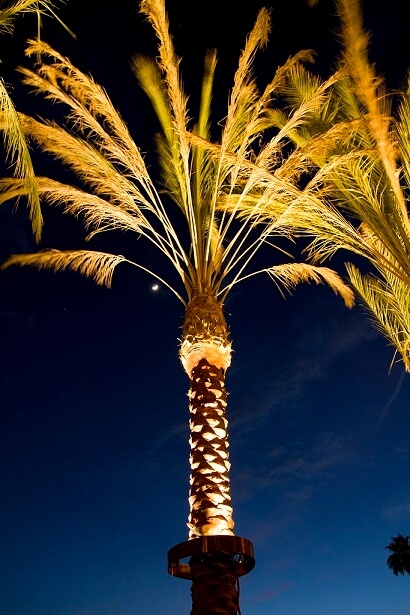
الخلاصة: دع أشجار النخيل الخاصة بك تتألق مثل النجوم
A. Recap Key Factors
Alright, let’s break it down one more time. When it comes to lighting your majestic palm trees, size absolutely matters. The bigger the tree, the bolder the lighting needs to be. But don’t just throw light everywhere—placement is key. You want to highlight the natural beauty of the tree while making sure your yard doesn’t look like an airport runway.
سطوع؟ إنه ليس مقاسًا واحدًا يناسب الجميع. تتطلب بعض اللحظات توهجًا لطيفًا، بينما تتطلب لحظات أخرى حالة تسليط الضوء الكاملة. درجة حرارة اللون؟ لديك خيارات. سواء كنت تشعر بالأجواء الدافئة والمريحة للإضاءة الناعمة أو الشعور العصري النقي باللون الأبيض الطبيعي، يمكن لأشجارك أن تتناسب مع أي مزاج. وأخيرًا، لا تنسَ نوع التركيبات - سواء كنت تقوم بتركيبها على الأرض، أو تعليقها من الفروع، أو تركيبها بسلاسة في المناظر الطبيعية، يجب أن تمزج تركيباتك بين الجمال والوظيفة.
ب. الأفكار النهائية
في نهاية النهار (وبداية الليل)، يمكن لإضاءة شجرة النخيل المناسبة أن تحول مساحتك الخارجية من "ممتاز" إلى "رائع". لكن الأمر لا يتعلق فقط بإلقاء بعض الأضواء على الشجرة والأمل في الأفضل. القليل من التخطيط يقطع شوطا طويلا. فكر في ما تريد تسليط الضوء عليه، وكم الضوء الذي تحتاجه، وكيف يمكنك خلق توازن بين الأجواء والتطبيق العملي.
فهيا، وأطلق العنان لمصمم الإضاءة الداخلي الخاص بك. دع نخيلك يتوهج بالهدف، ويحول ساحتك إلى موضع حسد الجيران. لأنه عندما يتم تنفيذها بشكل صحيح، فإن إضاءة شجرة النخيل لا تضيء فحسب، بل تتحول.
